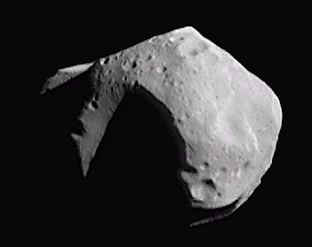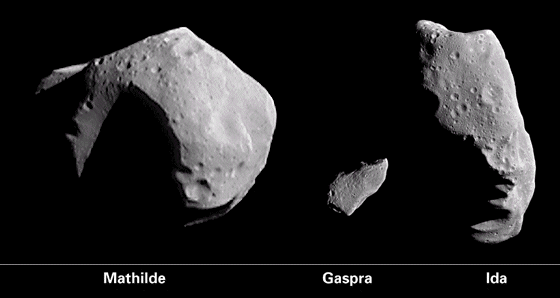
On June 27, 1997 the Near-Earth Asteroid Rendezvous (NEAR) spacecraft flew past asteroid 253 Mathilde. NEAR was the first mission of NASA's low-cost discovery missions and the first discovery spacecraft to return scientific data from an encounter. The primary mission of NEAR is an encounter with the asteroid 433 Eros in February 1999. The encounter with Mathilde was frought with difficulty. A year before the launch mission designers discovered that NEAR would pass close to the asteroid Mathilde on its way to Eros. Should the trajecotry of NEAR be modified to encounter Mathilde and use some of the precious fuel needed for the Eros encounter? Scientists were also concerned about possible dust particles damaging the spacecraft as NEAR and Mathilde crossed paths at a speed of 10 kilometers per second.
Previous to the encounter, very little was know about Mathilde. It was discovered by Johanna Palisa on November 12, 1885 in Vienna, Austria. Mathilde is a very unusual asteroid. It has an extreamly long rotation peroid of 415 hours. Only two other asteroids (1220 Clocus and 288 Glauke) are known to have longer rotation peroids. Mathilde is also one of the blackest objects in the solar system, reflecting only 3% of the light that strikes it. As one scientist said, "It is blacker than coal" or two times the darkness of a chunk of charcoal.
Mathilde is the largest asteroid to be visited by spacecraft. It is 52 kilometers (33 miles) in diameter and is approximately four times the size of Gaspra and two times the size of Ida. Ida and Gaspra were visited by the Galileo spacecraft on October 29, 1991 and August 28, 1993 respectively.
On June 27, 1997 NEAR made a spectatular 25 minute flyby of Mathilde which resulted in more than 500 images of a dark, crater-battered little world that dates to the beginning of the solar system. Mathilde is classified as a carbon rich C-type asteroid.

These are views of the three asteroids that have been imaged at close range by spacecraft. The image of Mathilde (left) was taken by the NEAR spacecraft on June 27, 1997. Images of the asteroids Gaspra (middle) and Ida (right) were taken by the Galileo spacecraft in 1991 and 1993, respectively. All three objects are presented at the same scale. The visible part of Mathilde is 59 km wide x 47 km high (37 x 29 miles). Mathilde has more large craters than the other two asteroids. The relative brightness has been made similar for easy viewing; Mathilde is actually much darker than either Ida or Gaspra.
Back To Asteroid Menu
Use the "BACK" button on your Browser to return to the previous page.